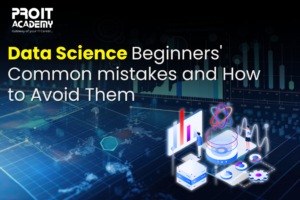Data Analysis is essential as so many firms today generate enormous amounts of data. As data analysis has advanced over time, two new positions—Data Analyst and Data Scientist—have emerged. Furthermore, in today’s data-driven economy, firms depend more and more on data analysis to support their decisions. Understanding the differences between recently emerging professions like Data Analysts and Data Scientists is essential to choose the one that best suits your professional goals. Even when two professions are similar, their responsibilities, salaries, and skill requirements differ. We will look more closely at the differences between Data Analysts and Data Scientists in this blog post.
What is a Data Analyst?
A Data Analyst’s role is to collect, clean, and interpret data in order to generate insights that have an impact on business decisions. They deal with organised, table-based structured data that has rows and columns. Data Analysts analyse data, spot trends, and provide visualisations using statistical tools and processes to make the data easier for stakeholders to understand.
A Data Analyst’s main objective is to assist organisations in making data-driven decisions. They collaborate with many interested stakeholders, including team members, managers, and executives. Additionally, Data Analysts must search for patterns and trends in the data and strive to present insightful facts that could impact business decisions.

Skills Set Required for Data Analysts
Data Analysts must have advanced skills in statistical analysis, data visualisation, and database management. They must be proficient in the use of data analysis programmes including Excel, SQL, and Python. They must also have excellent communication skills if they are to deliver their results to stakeholders in a clear and concise manner.
Data Analysts shouldn’t have any trouble handling large data volumes, and they should be able to modify and clean up the data to maximise its value. They should also be able to recognise patterns and trends in data and create visualisations that make the information easier for stakeholders to understand.
Job Responsibilities of a Data Analyst
The job responsibilities of a Data Analyst can vary depending on the organization they work for. However, their primary responsibilities include:
- Collecting and organizing data
- Cleaning and transforming data
- Analysing data
- Creating visualizations
- Communicating findings to stakeholders
Data Analysts are in charge of ensuring that the data is reliable and suitable for use in making business decisions. To help stakeholders understand the data and make wise decisions, they collaborate to produce reports and visualisations.
Tools and Techniques Used by Data Analysts
Data Analysts typically use statistical tools and techniques like regression analysis, hypothesis testing, and data visualisation. They use these tools to analyse data, find patterns, and pinpoint trends. They also use tools like Excel, SQL, and Python to modify and analyse data.
Data Analysts may create interactive dashboards and reports using data visualisation tools like Tableau and Power BI. These visualisations help stakeholders grasp the information and make wise decisions.
What is a Data Scientist?
Data Scientists are in charge of using data to solve challenging issues. They work with text, images, and video in addition to organised and unstructured data. Data Scientists use Machine Learning and predictive analytics algorithms to develop predictive models and identify trends in the data.
Data Scientists must have a solid background in programming, Machine Learning, and Statistics. In order to communicate their findings to both technical and non-technical clients, they must also be effective communicators.
A Data Scientist’s main objective is to assist organisations in making data-driven decisions. They search for patterns and trends in data that could aid organisations in streamlining their processes and making better decisions.

Book Your Time-slot for Counselling !
Skill Set Required for Data Scientists
Data Scientists need to be well-versed in programming, Machine Learning, and Statistics. Python, R, and SQL are three programming languages that they need to be experienced in. An understanding of statistical modelling and Machine Learning methods should also be required.
Both structured and unstructured data should be workable for data scientists, and they should be able to clean up and modify data to make it more useful. Additionally, they should be able to spot patterns and trends in data and build models that use the data to predict outcomes.
To effectively and succinctly present their findings to stakeholders, Data Scientists must also possess good communication skills. They need to be able to communicate complex ideas to stakeholders in a simple and clear manner.
Job Responsibilities of a Data Scientist
The job responsibilities of a Data Scientist can vary depending on the organization they work for. However, their primary responsibilities include:
- Collecting and organizing data
- Cleaning and transforming data
- Analysing data using Machine Learning algorithms and statistical models
- Creating predictive models and algorithms
- Communicating findings to stakeholders
Data Scientists are in charge of analysing complex issues and creating future predictions using data. They seek to create models that can recognise patterns and trends in data in order to make projections that are more accurate.

Do you need help to create your career path ?
Tools and Techniques Used by Data Scientists
Data Scientists utilise a variety of tools and approaches to model and analyse data. They develop Machine Learning strategies and statistical models using programming languages like Python and R. They utilise tools like Hadoop and Spark to cope with large data as well.
Additionally, Data Scientists produce interactive reports and dashboards using tools for data visualisation like Tableau and Power BI. These visualizations can help stakeholders understand the data and make better decisions.
Difference Between Data Analyst and Data Scientist
Skill Set: Data Analysts need a solid background in Statistics, Data Visualisation, and Database Management in order to be successful. But a solid background in programming, Machine Learning, and Statistics is also essential for data scientists.
Job Responsibilities: Data Analysts are in charge of collecting, cleaning, and transforming data in order to produce insights that guide corporate decisions. Data Scientists are in charge of using data to solve complicated issues, build models, and make predictions.
Tools and Techniques: Data Analysts use a variety of statistical tools and techniques, such as regression analysis, hypothesis testing, and data visualisation. Predictive analytics, Machine Learning, and deep learning are all used by data scientists.
Salaries: Data Scientists typically earn higher salaries than Data Analysts due to the additional skills and responsibilities required for the role.
Data Analyst vs Data Scientist Salary
In general, Data Scientist earn higher salaries than Data Analyst due to the additional skills and responsibilities required for the role. According to Glassdoor, the average salary for a Data Analyst in the United States is $62,453 per year, while the average salary for a Data Scientist is $113,309 per year.
Data Analyst vs Data Scientist salary in India
In India, the average salary for a Data Analyst is ₹399,877 per year, while the average salary for a Data Scientist is ₹843,616 per year, according to Glassdoor.
Are Data Analysts and Data Scientists the Same?
While there are some similarities between Data Analysts and Data Scientists, they are not the same. One way to think about the difference is that whereas Data Scientists focus on the future, Data Analysts concentrate on the past. ProIT Academy provides the best Data Analytics training in Pune with sessions led by the smartest minds in the industry.
The majority of the time, Data Analysts utilise statistical methods and tools to evaluate structured data and produce data visualisations. They put a lot of effort into comprehending the past and offering perceptions that guide corporate decisions. To determine which products are selling well and which are not, for example, a Data Analyst can analyse sales data.
On the other hand, Data Scientists work with both structured and unstructured data and use algorithms for Machine Learning and predictive analytics to build models that can predict the future and identify trends in data. They focus on predicting possible future events and offering information that enables businesses to improve their processes and make better decisions. To help the business retain those consumers, a data scientist might develop a model that forecasts which clients are most likely to churn in the following month.
Another way to think about the difference is that Data Analysts often concentrate on offering insights to particular business units or departments within a company, whereas Data Scientists concentrate on finding solutions to challenging issues that have an impact across the company. For instance, Data Analysts may closely collaborate with the marketing or finance departments, whereas Data Scientists may work on projects that have an impact on the overall strategy of the company.
Data Analysts frequently possess high proficiency in Statistics, data visualisation, and data analysis software like Excel and SQL. On the other side, Data Scientists often have more extensive knowledge of Big Data tools like Hadoop and Spark, Machine Learning methods, and programming languages like Python and R.
It is also important to keep in mind that in some organisations, the roles of Data Analysts and Data Scientists can overlap. For example, some Data Scientists spend more time on data cleansing and data visualisation, while some Data Analysts may have a high level of expertise in Machine Learning and predictive analytics. The particular requirements and objectives of the organisation will ultimately determine the responsibilities of Data Analysts and data scientists. If you wish to be a successful data analyst and land your dream job, connect with ProIT Academy.
Conclusion
In conclusion, Data Analysis has become an integral part of today’s business world, and with the emergence of new roles such as Data AnalystvsData Scientist, it is important to understand the Data AnalystandData Scientist difference. While both professional roles involve working with data, they differ in terms.
Data Analysts focus on analysing data using statistical tools and techniques to provide insights that inform business decisions, while Data Scientists use Machine Learning algorithms and predictive analytics to create models that can make predictions and detect patterns in data. Both roles are important for organizations that want to use data to inform decision-making, and organizations should carefully consider their needs and requirements before deciding to hire a Data Analyst or Data Scientist.











